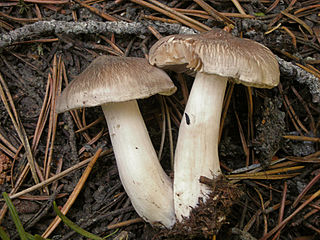
Tricholoma is a genus of fungus that contains many fairly fleshy white-spored gilled mushrooms which are found worldwide generally growing in woodlands. These are ectomycorrhizal fungi, existing in a symbiotic relationship with various species of coniferous or broad-leaved trees. The generic name derives from Ancient Greek: τριχο-, romanized: tricho-, lit. 'hair' and Ancient Greek: λῶμα, romanized: loma, lit. 'fringe, border' although only a few species have shaggy caps which fit this description.
Tricholoma venenatum is a mushroom of the agaric genus Tricholoma. It was first described scientifically by American mycologist George F. Atkinson in 1908.

Tricholoma myomyces is a mushroom of the agaric genus Tricholoma, usually considered to be a synonym of Tricholoma terreum. The species was first described scientifically by Christian Hendrik Persoon in 1794 as Agaricus myomyces, and later transferred to the genus Tricholoma by Danish mycologist Jakob Emanuel Lange in 1933. It is found in Europe and northern North America.

Tricholoma nigrum is a mushroom of the agaric genus Tricholoma. It was described as new to science in 1996 from a collection made on the Oregon Coast where it occurred with Pinus contorta. It has also been found in an old-growth conifer forest.

Tricholoma virgatum, commonly known as the ashen knight, is a mushroom of the agaric genus Tricholoma. It was first described scientifically as Agaricus virgatus by Elias Fries in 1818, and later transferred to the genus Tricholoma by Paul Kummer in 1871. It is found in the deciduous and coniferous forests of Europe, North America, and China. The mushroom is inedible, speculated to be poisonous, and has a bitter and peppery taste and musty odor.

Tricholoma imbricatum is a species of agaric fungus in the family Tricholomataceae. Commonly known as the matt knight, it is found in Europe and North America, where it grows on the ground in coniferous forests. Fruit bodies have a brown to reddish-brown cap, which is often scaly, and ranges from 6–18 cm in diameter, and a stipe that is 3.5–12 cm long by 1–3 cm thick. The gills are initially whitish in color before developing reddish-brown spots. The spores are white.

Tricholoma ustale, commonly known as the burnt knight, is a species of mushroom in the large genus Tricholoma. It is found in Asia, Europe, and North America, though those from North America may represent one or more different species.

Tricholoma aurantio-olivaceum is a mushroom of the agaric genus Tricholoma. It was first formally described by American mycologist Alexander H. Smith in 1944.
Tricholoma atroviolaceum is a mushroom of the agaric genus Tricholoma. It is from the fungi kingdom. It was described as new to science by American mycologist Alexander H. Smith in 1944. The mushroom seems to be exclusive to the Pacific coast of North America; it can be found in the Pacific Northwest under conifers, usually in sparse quantities.

Tricholoma apium is a mushroom of the agaric genus Tricholoma that is found in Europe. It is classified as vulnerable in the IUCN Red List of Threatened Species.

Tricholoma cingulatum is a mushroom of the agaric genus Tricholoma. First described in 1830 as Agaricus cingulatus by Elias Magnus Fries, it was transferred to the genus Tricholoma by Almfelt in 1830.
Tricholoma fulvimarginatum is a mushroom of the agaric genus Tricholoma. Described as new to science in 1986, it is found in eastern North America.
Tricholoma insigne is a mushroom of the agaric genus Tricholoma. It was described as new to science in 1989.

Tricholoma luteomaculosum is a mushroom of the agaric genus Tricholoma. It was first formally described by American mycologist Alexander H. Smith in 1942.

Tricholoma manzanitae is a mushroom of the agaric genus Tricholoma. It was formally described in 1983.

Tricholoma muricatum is a mushroom of the agaric genus Tricholoma. It was described as new to science in 1996. It tends to grow near pines.
Tricholoma palustre is a mushroom of the agaric genus Tricholoma. It was formally described by American mycologist Alexander H. Smith in 1942.

There are numerous wild edible and medicinal plants in British Columbia that are used traditionally by First Nations peoples. These include seaweeds, rhizomes and shoots of flowering plants, berries, and fungi.













